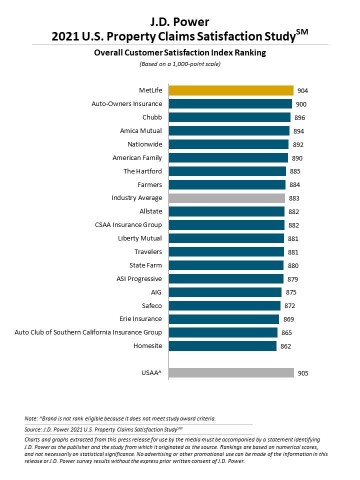Digital transformation became more than a buzzword for home insurers at the onset of the COVID-19 pandemic—it also became the key to faster claims settlement, payment and record high levels of customer satisfaction. The J.D. Power 2021 U.S. Property Claims Satisfaction Study,SM released today, tracked customer experiences with home insurance claims both before and during the COVID-19 pandemic. The study finds that customer adoption of digital claims reporting, estimation and, most importantly, insurers’ use of photos/videos for estimation increased during 2020. Submission of fully digital claims reduced the average time to payment by up to 5.5 days and helped drive the highest overall satisfaction scores ever measured in the study’s 14-year history.
This press release features multimedia. View the full release here: https://www.businesswire.com/news/home/20210225005029/en/

J.D. Power 2021 U.S. Property Claims Satisfaction Study (Graphic: Business Wire)
“Insurers have been touting digital first notice of loss, mobile apps and software for pre-claim home content inventory cataloging, but customer adoption stayed stubbornly low—until COVID-19 hit,” said Robert Lajdziak, senior consultant, insurance intelligence at J.D. Power. “Overall use of technology—particularly on behalf of the carriers—increased significantly during the past year, creating direct benefits such as faster claims and secondary benefits such as a more consistent claims process for all customers. The key now is addressing some of the lingering issues that create breaks in the digital claims process and continued improvement to convenience and adherence to best practices.”
Following are some key findings of the 2021 study:
- Increased use of digital claims tools drives faster payment, improved satisfaction: Overall customer satisfaction with homeowners insurance property claims is a record-high 883 (on a 1,000-point scale), as more customers than ever have adopted digital claims tools. On average, when homeowners engaged in fully digital claims processing, including estimation and first notice of loss (FNOL), the time to payment was reduced up to 5.5 days.
- Pre-claim inventory cataloging key to customer satisfaction: Use of mobile apps and insurer-provided software for inventory creation is up more than 33% since 2018. When inventory lists were created prior to a loss, customers received payment 3.4 days faster than when the inventory list was made after the loss. Likewise, overall satisfaction is 19 points higher among those customers with pre-loss inventories. Such tools appeal to younger customers and increase customer engagement—not dissimilar to gamification/tools/services provided by insurtechs.
- Uneven performance when digital claims process is broken: While overall customer satisfaction and time to payment are improved when claimants complete their entire claims process digitally, satisfaction scores fall when breaks in the digital chain occur. For example, satisfaction is significantly lower among claimants who unsuccessfully tried to utilize a fully digital reporting and estimation process compared with those who do not use digital channels at all. The process breaks when digital reverts to an offline experience and customers spend more time and energy to achieve the same outcome.
- Digital democratizing claims experience: Traditionally, bundlers and older customers have higher satisfaction scores and are more likely to experience key performance indicators (KPIs) throughout the claim experience than Gen Y/Z1 or monoline customers. In 2020, claimants making their claim digitally had similar satisfaction scores and a more consistent customer experience in the number of KPIs that were achieved, regardless of whether the customer had multiple policies bundled with the insurer. Additionally, Gen Y/Z overall satisfaction is similar for both online and offline reporting, while satisfaction among Boomers declines nearly 30 points with online reporting.
Study Ranking
MetLife ranks highest in property insurance claims experience, with a score of 904. Auto-Owners Insurance (900) ranks second and Chubb (896) ranks third.
The U.S. Property Claims Satisfaction Study measures satisfaction with the property claims experience among insurance customers who have filed a claim for damages by examining five factors (listed in order of importance): settlement; claim servicing; FNOL; estimation process; and repair process. The study is based on responses from 6,112 homeowners insurance customers who filed a claim within the previous nine months. It was fielded from April through November 2020.
For more information about the U.S. Property Claims Satisfaction Study, visit https://www.jdpower.com/business/resource/us-property-claims-satisfaction-study.
To view the online press release, please visit http://www.jdpower.com/pr-id/2021015.
J.D. Power is a global leader in consumer insights, advisory services and data and analytics. A pioneer in the use of big data, artificial intelligence (AI) and algorithmic modeling capabilities to understand consumer behavior, J.D. Power has been delivering incisive industry intelligence on customer interactions with brands and products for more than 50 years. The world’s leading businesses across major industries rely on J.D. Power to guide their customer-facing strategies.
J.D. Power is headquartered in Troy, Mich., and has offices in North America, Europe and Asia Pacific. To learn more about the company’s business offerings, visit JDPower.com/business. The J.D. Power auto shopping tool can be found at JDPower.com.
About J.D. Power and Advertising/Promotional Rules: www.jdpower.com/business/about-us/press-release-info
1 J.D. Power defines generational groups as Pre-Boomers (born before 1946); Boomers (1946-1964); Gen X (1965-1976); Gen Y (1977-1994); and Gen Z (1995-2004). Millennials (1982-1994) are a subset of Gen Y.
View source version on businesswire.com: https://www.businesswire.com/news/home/20210225005029/en/
